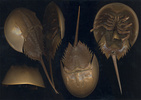Back to Profile Page
Tree of Life Media Contributed By Matthew Chung
|
ID
|
Thumbnail |
Media Data |
| 32453 |

|
|
| 32459 |

|
|
| 32461 |

|
|
Comments
|
The Great Horeshoe Crab Hunt. During the spawning season of the Atlantic horseshoe crab, between the months of May and June, a female horseshoe crab can lay between two to thirty thousand eggs, which are then covered by a layer of sand. However, horseshoe crabs are a source of food for various species of shorebirds along the Atlantic coast. In the following activity, you are a hungry shorebird, looking for horseshoe crab eggs buried underneath the sand. Using the clues listed below, uncover as many horseshoe crab eggs you can, colouring them in pale-green.
|
|
Copyright
|
© 2008 Matthew Chung

|
|
Image Use
|
ToL use only
|
|
Attached to Group
|
Limulus polyphemus: view page image collection
|
|
Title
|
thegreathorseshoecrabhunt.jpg
|
|
Image Type
|
Diagram
|
|
Technical Information
|
Word Search Activity
|
|
ID
|
32461
|
|
| 32462 |

|
|
Copyright
|
© 2008 Matthew Chung

|
|
Document Use
|
ToL use only
|
|
Attached to Group
|
Limulus polyphemus: view page
|
|
Title
|
The Great Horseshoe Crab Hunt
|
|
Description
|
The Great Horeshoe Crab Hunt. During the spawning season of the Atlantic horseshoe crab, between the months of May and June, a female horseshoe crab can lay between two to thirty thousand eggs, which are then covered by a layer of sand. However, horseshoe crabs are a source of food for various species of shorebirds along the Atlantic coast. In the following activity, you are a hungry shorebird, looking for horseshoe crab eggs buried underneath the sand. Using the clues listed below, uncover as many horseshoe crab eggs you can, colouring them in pale-green. Word search activity intended to reinforce knowledge of the horseshoe crab.
|
|
Document Content
|
Teacher Resource, Lesson, Activity or Project, Lesson/Activity Support Materials, Vocabulary
|
|
ToL Learner Level
|
Beginner, Intermediate
|
|
ID
|
32462
|
|
Please note: Most images and other media displayed on the Tree of Life web site are protected by copyright, and the ToL cannot act as an agent for their distribution. If you would like to use any of these materials for your own projects, you need to ask the copyright owner(s) for permission. For additional information, please refer to the
ToL Copyright Policies.




 This media file is licensed under the
This media file is licensed under the 
 Go to quick links
Go to quick search
Go to navigation for this section of the ToL site
Go to detailed links for the ToL site
Go to quick links
Go to quick search
Go to navigation for this section of the ToL site
Go to detailed links for the ToL site